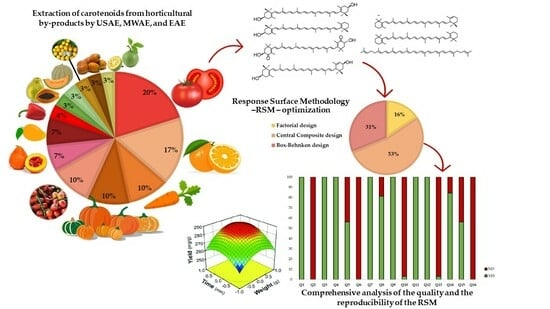Response Surface Methodology to Optimize the Extraction of Carotenoids from Horticultural By-Products—A Systematic Review
Abstract
Share and Cite
Cano-Lamadrid, M.; Martínez-Zamora, L.; Mozafari, L.; Bueso, M.C.; Kessler, M.; Artés-Hernández, F. Response Surface Methodology to Optimize the Extraction of Carotenoids from Horticultural By-Products—A Systematic Review. Foods 2023, 12, 4456. https://doi.org/10.3390/foods12244456
Cano-Lamadrid M, Martínez-Zamora L, Mozafari L, Bueso MC, Kessler M, Artés-Hernández F. Response Surface Methodology to Optimize the Extraction of Carotenoids from Horticultural By-Products—A Systematic Review. Foods. 2023; 12(24):4456. https://doi.org/10.3390/foods12244456
Chicago/Turabian StyleCano-Lamadrid, Marina, Lorena Martínez-Zamora, Laleh Mozafari, María Carmen Bueso, Mathieu Kessler, and Francisco Artés-Hernández. 2023. "Response Surface Methodology to Optimize the Extraction of Carotenoids from Horticultural By-Products—A Systematic Review" Foods 12, no. 24: 4456. https://doi.org/10.3390/foods12244456
APA StyleCano-Lamadrid, M., Martínez-Zamora, L., Mozafari, L., Bueso, M. C., Kessler, M., & Artés-Hernández, F. (2023). Response Surface Methodology to Optimize the Extraction of Carotenoids from Horticultural By-Products—A Systematic Review. Foods, 12(24), 4456. https://doi.org/10.3390/foods12244456















